|
Upper Kotmale to generate power in January:
An investment for the future
By Shirajiv SIRIMANE
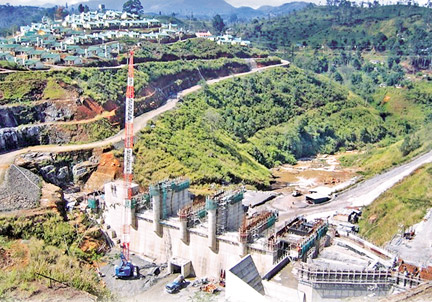 Creating yet another historic landmark in the country's power
generation sector, the long overdue Upper Kotmale hydro power plant
project is to be ready by January. Creating yet another historic landmark in the country's power
generation sector, the long overdue Upper Kotmale hydro power plant
project is to be ready by January.
Engineers say that over 75 percent of the project is now completed;
the final stages are now under way.
Engineers have created a 25 hectare reservoir across the Kotmale Oya
and a 35.5 metre tall and 180 metre long dam is being built across it.
In addition to the Sri Lankan staff, employees of Japan's Mayeda Company
are involved in the construction of the project.
The Upper Kotmale hydro power plant was one of the most controversial
projects in the country due to the bleak picture of the project
presented by environmentalists. They went to the extent of saying that
the implementation of the project would result in earthquakes in the
hill country and the waterfalls running dry.
In addition to the relocation of families, they said, flora and fauna
and the eco-circle in upcountry areas would be disturbed due to this
project. Opposition politicians too capitalised on this issue which
delayed the launch of the project.
|
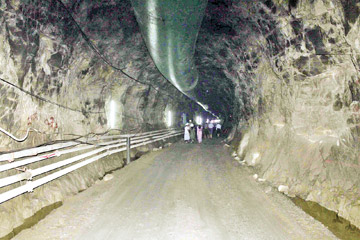
An interial view of the completed tunnel |
|
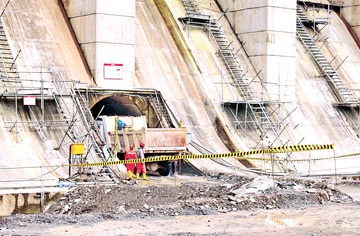
A lorry at the entrance of the tunnel |
|

The proposed St. Clair’s waterfall viewers’ gallery |
|

The new Urban Council building |
|
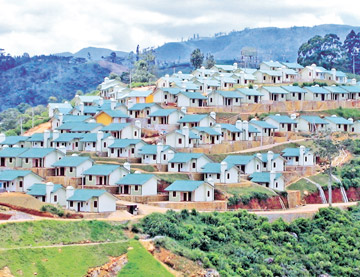
The housing facility for resettled families |
After President Mahinda Rajapaksa was elected to office, fresh
feasibility studies were carried out, some changes were made to the
initial plans and the project finally got off the ground in March 2006.
It must also be mentioned that this project was initially planned to
commence in 1985 and was delayed by two decades due to controversies.
In addition to ironing out the controversy, obtaining funding for the
project too was a grey area. The President negotiated with the Japan
International Co-operation Agency and was able to secure USD 297 million
on a 30-year long-term credit. The Government invested USD 87 million in
making the project a reality.
Today, with the project nearing completion, the myths and
controversies have died a natural death.
Project Director, Upper Kotmale Project, Shavindra Fernando told the
Sunday Observer that the very people who were against it and though the
project would destroy them are now dependent on it.
The project will also have a positive impact on the local
communities, providing opportunities for improved social and economic
development. It will stimulate local business growth with opportunities
created by the presence of construction camps and increased local
disposable incomes.
"Today, over 2,000 people are working there and the infrastructure
that came their way due to the project was pleasing," he said.
They have now been relocated in new houses. The actual floor area of
the houses varies from estate to estate and also within estates.
However, the area is typically between 200 and 350 square feet.
Housing
"Their housing is better than some of the houses in the cities and
they are ever thankful to the Government for that. The business
community also expects some benefits due to local tourism from the
reservoir landscape, attracting people to use restaurants and other
facilities in the town.
A new town hall, fit to be a 'mini white house' was constructed to
replace the dilapidated building and this is the "Pride of the place"
now. Similarly, the main school and cinema hall were rebuilt to high
standards, giving the residents something to boast about. The old estate
roads too were widened and re-laid with new bridges and culverts. This
includes an 80 metre bridge across Kotmale Oya built at a cost of Rs. 77
million. Temples, kovils and mosques were relocated and rebuilt along
with six libraries, 33 business premises and six factories.
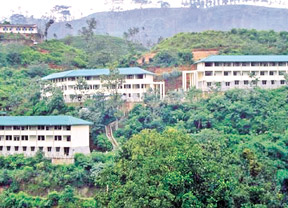
The new Tamil school |
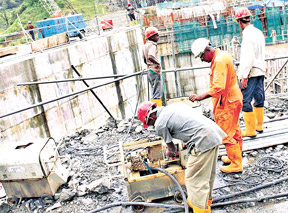 |
| Work in
progress |
The total cost of the construction of buildings and associated
infrastructure is Rs. 600 million.
The development of the Upper Kotmale hydro power project will change
the socio-economic situation in this area. It will provide the local
areas with a number of environmental and social benefits both during the
construction phase and operation phase. While the local social benefits
will be largely confined to the area around the Talawakelle town, the
wider benefits of watershed management will extend to the entire upper
basin.
Environmental clearance
He also emphasised that the St. Clair's waterfall would not run dry
due to the project. "We will be converting the waterfall into a major
tourist attraction with nature trails, a viewing gallery being
constructed and facilities for people to go to the basin of the
waterfall which is now not possible," Fernando said.
The Secretary of the Ministry of Forestry and Environment granted the
environmental clearance for the Upper Kotmale Project with some
pre-conditions in March 2000. One of the conditions was that the Central
Environmental Authority (CEA) should appoint a monitoring committee to
evaluate the implementation of the proposed mitigation measures by the
Ceylon Electricity Board (CEB). He also pointed out that this is not the
world's first hydro power project and for centuries it has been proven
that they have had no negative impacts.
Fernando also said that they are building a special protection and
restoration bank around the reservoir so that there is no soil erosion.
In addition, one million trees including bamboo trees would be planted
around the reservoir of which 250,000 have already been planted.
"Similarly, many other precautionary measures have also been taken," he
said.
The project will provide infrastructure development including roads,
electricity, telecommunications, water supply, clinics and garbage
disposal facilities. These improvements will certainly enhance the
continuing development of the area.
The Upper Kotmale project will show its environment improvement
effects in global as well as local terms.
He said that a project of this nature should have been completed five
years ago as the country needs to get set to meet the growing demand for
power in future. "Sri Lanka's electricity requirement has been growing
at an average rate of seven to eight percent annually, and this trend is
expected to continue in the foreseeable future. To meet the high growth
rate of demand for electricity, CEB's Long-Term Generation Expansion
Plan for 2002-2016 envisions this project," he said. This project would
generate 150 megawatts. The waters of the Kotmale Oya will be diverted
at the Talawakele Intake dam, into the headrace tunnel (length - 12.5
km), and then to the powerhouse, which is located about one kilometre
downstream.
A 220 kV double circuit transmission line will convey the electricity
to the existing Kotmale Switchyard with a 17.5 km transmission line.
Hydro power is still the world's cheapest source of power generation and
this is an investment made with the country's future in mind.
|

